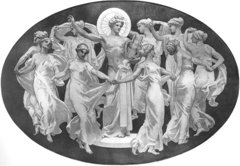Charites
|
|
| Greek deities series | |
|---|---|
| Primordial deities | |
| Titans and Olympians | |
| Aquatic deities | |
| Chthonic deities | |
| Other deities | |
| Personified concepts | |
Threegraces.jpg
In Greek mythology, the Charites were the graces. Ordinarily they were three: Aglaea, the youngest, Euphrosyne and Thalia (according to the Spartans, Cleta was the third), but others are sometimes mentioned, including Auxo, Charis, Hegemone, Phaenna, and Pasithea (see Pausanius below).
They were the daughters of Zeus and Eurynome, usually, though also said to be daughters of Dionysus and Aphrodite or of Helios and the naiad Aegle. Homer claimed they were part of the retinue of Aphrodite. Their Roman equivalent were the Gratiae.
The Charites were the goddesses of charm, beauty, nature, human creativity and fertility. They were great lovers of beauty and gave humans talents in the arts, closely associated with the Muses. The Charites were associated with the underworld and the Eleusinian Mysteries.
The river Cephissus near Delphi was sacred to them.
Pausanias, interrupts his Description of Greece (book 9.xxxv.1 - 7) to expand upon the various conceptions of the Graces that obtained in different parts of mainland Greece and Ionia:
- "The Boeotians say that Eteocles was the first man to sacrifice to the Graces. Moreover, they are aware that he established three as the number of the Graces, but they have no tradition of the names he gave them. The Lacedaemonians, however, say that the Graces are two, and that they were instituted by Lacedaemon, son of Taygete, who gave them the names of Cleta and Phaenna. These are appropriate names for Graces, as are those given by the Athenians, who from of old have worshipped two Graces, Auxo and Hegemone... It was from Eteocles of Orchomenus that we learned the custom of praying to three Graces. And Angelion and Tectaus, sons of Dionysus, who made the image of Apollo for the Delians, set three Graces in his hand. Again, at Athens, before the entrance to the Acropolis, the Graces are three in number; by their side are celebrated mysteries which must not be divulged to the many. Pamphos was the first we know of to sing about the Graces, but his poetry contains no information either as to their number or about their names. Homer (he too refers to the Graces ) makes one the wife of Hephaestus, giving her the name of Grace. He also says that Sleep was a lover of Pasithea, and in the speech of Sleep there is this verse:--
- Verily that he would give me one of the younger Graces.
- "Hence some have suspected that Homer knew of older Graces as well. Hesiod in the Theogony (though the authorship is doubtful, this poem is good evidence ) says that the Graces are daughters of Zeus and Eurynome, giving them the names of Euphrosyne, Aglaia and Thalia. The poem of Onomacritus agrees with this account. Antimachus, while giving neither the number of the Graces nor their names, says that they are daughters of Aegle and the Sun. The elegiac poet Hermesianax disagrees with his predecessors in that he makes Persuasion also one of the Graces."
The Charites in art
On the representation of the Graces, Pausanis wrote,
- "Who it was who first represented the Graces naked, whether in sculpture or in painting, I could not discover. During the earlier period, certainly, sculptors and painters alike represented them draped. At Smyrna, for instance, in the sanctuary of the Nemeses, above the images have been dedicated Graces of gold, the work of Bupalus; and in the Music Hall in the same city there is a portrait of a Grace, painted by Apelles. At Pergamus likewise, in the chamber of Attalus, are other images of Graces made by Bupalus; and near what is called the Pythium there is a portrait of Graces, painted by Pythagoras the Parian. Socrates too, son of Sophroniscus, made images of Graces for the Athenians, which are before the entrance to the Acropolis. All these are alike draped; but later artists, I do not know the reason, have changed the way of portraying them. Certainly to-day sculptors and painters represent Graces naked."
The Charites are depicted together with several other mythological figures in Sandro Botticelli's painting Primavera (above right). Among other artistic depictions, they are the subject of famous sculptures by Antonio Canova and Bertel Thorvaldsen.
A group of three trees in the Calaveras Big Trees State Park are named "The Three Graces" after the Charites.de:Chariten es:Gracia fr:Charites it:Grazie nl:Cleta pl:Gracje ro:Graţii

